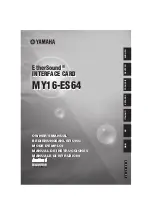
User's Guide HDSP System HDSP 9652
© RME
41
Note that in record or monitor modes, set emphasis bits will disappear. Recordings origi-
nally done with emphasis should always be played back with the emphasis bit set!
This can be done by selecting the
Emphasis
switch in the Settings dialog (field
SPDIF Out
).
This setting is updated immediately, even during playback.
The HDSP 9652’s new output header is optimized for largest compatibility with other digital
devices:
•
32 kHz, 44.1 kHz, 48 kHz, 88.2 kHz, 96 kHz depending on the current sample rate
•
Audio use, Non-Audio
•
No Copyright, Copy Permitted
•
Format Consumer or Professional
•
Category General, Generation not indicated
•
2-channel, No Emphasis or 50/15 µs
•
Aux bits Audio Use
Professional AES/EBU equipment can be connected to the HDSP 9652 thanks to the trans-
former-balanced coaxial output, and the ‘Professional’ format option with doubled output volt-
age. Output cables should have the same pinout as those used for input (see above), but with a
male XLR plug instead of a female one.
Note that most consumer HiFi equipment (with optical or phono SPDIF inputs) will only ac-
cept signals in ‘Consumer’ format!
The audio bit in the header can be set to 'Non-Audio'. This is often necessary when Dolby AC-3
encoded data is sent to external decoders (surround-sound receivers, television sets etc. with
AC-3 digital inputs), as these decoders would otherwise not recognize the data as AC-3.
22.3 Word Clock
The HDSP 9652's word clock input is a high impedance type (not terminated). Termination with
75 Ohm is available via jumper
X105
on the Expansion Board.
Thanks to a low impedance, but short circuit proof output, the HDSP 9652 delivers 4 Vpp to 75
Ohms. For wrong termination with 2 x 75 Ohms (37.5 Ohms), there are still 3.3 Vpp at the out-
put.
Selecting
Single Speed
in the Settings dialog causes the output signal to always stay within the
range of 32 kHz to 48 kHz. So at 96 kHz sample rate, the output word clock is 48 kHz.
22.4 MIDI
The HDSP 9652 offers two MIDI I/O via two 5-pin DIN connectors each. The MIDI ports are
added to the system by the driver. Using MIDI capable software, these ports can be accessed
under the name
HDSP MIDI
. Using more than one HDSP 9652, the operating system adds a
consecutive number to the port name, like
HDSP MIDI In (3)
etc.
The MIDI In port is available for both GSIF (GSIF-2 Low Latency) and standard MME MIDI si-
multaneously.
Содержание Hammerfall HDSP 9652
Страница 5: ...User s Guide HDSP System HDSP 9652 RME 5 User s Guide HDSP 9652 General...
Страница 11: ...User s Guide HDSP System HDSP 9652 RME 11 User s Guide HDSP 9652 Driver Installation and Operation Windows...
Страница 29: ...User s Guide HDSP System HDSP 9652 RME 29 User s Guide HDSP 9652 Driver Installation and Operation Mac OS X...
Страница 38: ...38 User s Guide HDSP System HDSP 9652 RME...
Страница 39: ...User s Guide HDSP System HDSP 9652 RME 39 User s Guide HDSP 9652 Connections and TotalMix...
Страница 45: ...User s Guide HDSP System HDSP 9652 RME 45...
Страница 66: ...66 User s Guide HDSP System HDSP 9652 RME...
Страница 67: ...User s Guide HDSP System HDSP 9652 RME 67 User s Guide HDSP 9652 Technical Reference...
Страница 75: ...User s Guide HDSP System HDSP 9652 RME 75 31 Block Diagram HDSP 9652...
















































